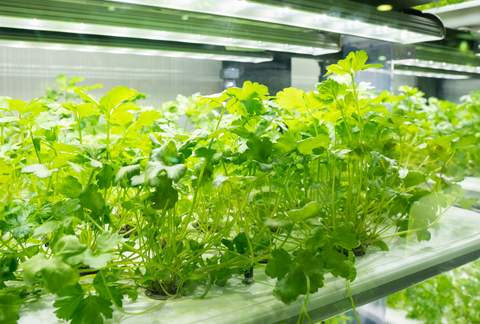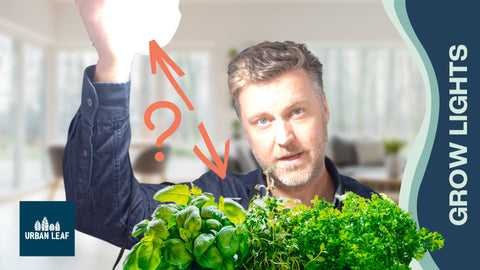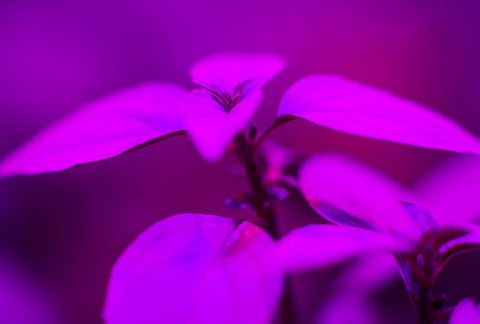In nature, plants use the duration of light and darkness to determine the time of year, which dictates key reproductive behaviors such as flowering and fruiting. For indoor food growers aiming to get flowers and ultimately vegetables or fruit, understanding how light and darkness impact your edible plants is crucial.
You might have the best watering, temperature, and fertilizer regime, but if the light durations are wrong, you may struggle to control the flowering process. This applies whether you're trying to encourage it (for fruits and vegetables) or inhibit it (for many herbs).
In the accompanying article, Plants Do Math At Night. How Long Should You Let Them Sleep?, we discussed why giving plants a daily rest period is critical and the important biological functions they perform when the lights are out.
In this article, we continue the conversation on grow lights, specifically addressing how long you should leave your grow lights on each day.
We've broken this article into two main parts:
- A 3-Step Process to calculate the optimum light intensity for your plants.
- A free online spreadsheet to help with your own calculations.
Let’s jump in.
Step 1 – Understand The ‘Ideal’ Hours Of Light Per Day For Your Plants
Short vs. Long Day Plants – How Their Light Needs Differ
Plants are categorized as either “long” or “short” day plants.
- Long-day plants need short periods of darkness to flower. Examples include basil, cilantro, parsley, dill, mint, and tomatoes.
- Short-day plants need long periods of darkness to flower. Examples include avocado, mustard greens, marigold, zinnia, and strawberry.
To emulate a plant’s ideal growing environment, look up its ideal day length and set the on/off timer on your grow light accordingly.
However, this approach can lead to quick flowering. For some plants like tomatoes and peppers, this is good as flowers produce fruit. But for others like lettuce and cilantro, flowering signals the end. Leaves change shape, taste becomes bitter, and it’s time to start over.
In addition to classifying plants by day length, consider whether flowering is desirable or not.
Using Light Duration To Promote (or Avoid) Flowering
For plants where flowering is desirable, provide the ideal light duration. For plants where flowering is undesirable, do the opposite. Here's a handy table to help you out:
| Long Day | Short Day | |
|---|---|---|
| Flowering Desirable |
Provide a long day:
|
Provide a short day:
|
| Flowering Undesirable |
Provide a short day: |
Provide a long day:
|
Is There A Limit To How Long You Can Leave Lights On?
Short answer: yes. Even long-day plants need a daily respiration period of at least 6 hours (for seedlings) and ideally 8-10 hours for mature plants. We do not recommend providing more than 14-16 hours of light per day, even for long-day varieties.
Step 2 – Understand The ‘Ideal’ Daily Light Integral (DLI) Requirements For Your Plants
Plants also have varying needs in terms of the ‘volume’ of light they accumulate per day, measured by ‘Daily Light Integral’ or DLI. Decorative indoor plants like pothos, snake plants, or monstera might be content with a DLI of 1-4 mol/m2/day, but most edible plants need a DLI of 10-30 mol/m2/day.
Side Note: What is DLI?
DLI measures how much light energy falls on a surface (like a plant leaf) in a 24-hour period. Just as humans need a certain number of calories each day, plants have their own DLI requirements. Failing to provide sufficient DLI will have similar effects to not getting enough calories: at best, you'll be cranky; at worst, you could perish.
Step 3 – Calculate The Ideal Light Intensity (PPFD) Requirements For Your Plants
Once you know a) the total volume of light a plant needs and b) the ideal duration to deliver it, divide one by the other to calculate the ideal delivery rate of that light (PPFD). This is similar to filling a 10-gallon bucket over 5 hours: divide 10 by 5 to get 2 gallons per hour.
We measure light flow rate in PPFD (photosynthetic photon flux density) in mol/m2/s. Here’s a summarized table of this math. If your plant isn't listed, leave a comment, and we'll add it.

Other Considerations in Determining How Many Hours a Day Are Needed for Indoor Plant Grow lights
Other considerations to keep in mind when determining how long to leave your Grow lights on for indoor plants include:
- Delivering the target DLI in too short a time period requires a high rate of flow (PPFD). Just like you can get sunburned, plants can also get ‘light burned’. Subjecting plants to excess PPFD is likely to cause their leaves to go brown.
- If you are having trouble getting a plant to flower (and you want it to flower) try very gradually to modify the day length. Gradually shortening day-lengths can ‘trick’ plants into thinking that the end of the growing season is approaching and winter is coming. They’ll want to get their fruit produced before that happens.
- Plants need to sleep. They perform important respiratory functions at night. Seedlings should have at least 6 hours of darkness per day, and more mature plants at least 8-10 hours.
We hope this guide to indoor edible gardening and grow lights has been useful. The next logical step from here is to take what you’ve learned about ideal PPFD and use that to determine the placement and type of grow light you need. If you’d like to learn more about this topic we recommend reading How Far Should Grow Lights Be From Plants as well as signing up for our email list below.
If you're ready to start enjoying the many benefits of growing indoors with a grow light, then here are a few of our favorite options:
- Best Hanging Option: If you have a wall or ceiling to hang your light, the Aspect grow light is ideal. Available in white and black, and in 20W or 40W.
- Best Free Standing Option: For a non-drilling option, try the PlantSpectrum. Available in 16" and 16W and 32" and 32W. Versatile and waterproof.
- Best Under-Cabinet Option: For bookshelves or countertops, check out the Grove. It offers various mounting options at an affordable price.
- Most Versatile Option: If you need flexibility, go with the Vita. Available as a stand-alone globe or a pendant kit. Compatible with any standard screw-style housing.
- Best Budget Option: For a simple, budget-friendly light for seed starting or a single herb, consider the compact grow light. Not suitable for large grow areas or fruits/vegetables.









Hello geturbanleaf.com webmaster, Your posts are always informative and up-to-date.